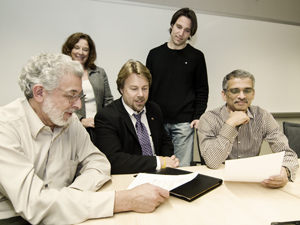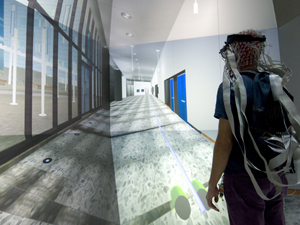Calit2 Receives $100,000 Contribution from HMC Architects for Research into Human Responses to Design
March 24, 2009 / By Tiffany Fox, (858) 246-0353, tfox@ucsd.edu
San Diego, CA., March 24, 2009 — HMC Architects, an award-winning designer of education, healthcare, and government facilities, is contributing more than $100,000 in cash and professional services over the next two years to the California Institute for Telecommunications and Information Technology (Calit2). The gift will expand the institute's multidisciplinary research into human responses to the built environment.
|
Calit2 at UC San Diego is the home of the StarCAVE virtual-reality (VR) environment, a 360-degree, 16-panel, 3-D immersive environment that enables researchers to interact with virtual architectural renderings in three dimensions, in real time and at actual scale.
"This technology ultimately allows us to put the 'evidence' into evidence-based design," said Randy Peterson, FAIA, LEED AP and president and CEO of HMC Architects. "We are looking to develop a system that will give us information to validate the positive effects buildings can have on users of all types — from patients, doctors, and visitors in healthcare settings to students, teachers, researchers and the general public in learning environments."
Prior research indicates that architectural design can have a significant impact on people experiencing the built environment. In hospitals, for example, certain design features have been shown to reduce medical errors and the risk of infections. When implemented in schools, design elements can enhance learning, as demonstrated by improved student test scores in math and English.
"We consider the StarCAVE to be a boundary technology that can inform us about how specific features of a building's design affect human responses, and also yield new insights on how the brain works," said Calit2's Eduardo Macagno, founding dean of the UC San Diego Division of Biological Sciences and president of the Academy of Neurosciences for Architecture (ANFA).
Calit2's research into the effects of design on human cognition and behavior began with its ongoing investigation into "way-finding," or the process one uses to navigate through architectural spaces. Together with Scott Makeig and Klaus Gramann of the UC San Diego-based Swartz Center for Computational Neuroscience, as well as Project Scientist Jürgen Schulze of Calit2 and neuroscientist Eve Edelstein, a visiting scholar at UCSD and an architect with HMC, Macagno and his team are developing an interactive and synchronized VR and electroencephalography (EEG) prototype in the StarCAVE to study the neural structures associated with way-finding.
The research, which was conceived by Macagno after attending a workshop sponsored by ANFA, aims to gain a better understanding of how humans create and use "cognitive maps" of architectural spaces. The researchers also hope to learn which cues are most easily recognized — and therefore the most successful — in helping users navigate through complex buildings.
|
Schulze says that the HMC funding will take the research one step further and make it possible for users to modify architectural models in real time within the StarCAVE.
He explains: "We are going to work with HMC's architects to find out what the most important editing functions are for them in this environment, and we will implement them for the StarCAVE, where they can be applied much more intuitively than they could on a desktop computer."
HMC has a growing interest in the neurological implications of architecture. In 2008, the firm hired Edelstein as senior vice president of research and design. Her role is to advise the firm's architects in the neurological effects of lighting, sound, orientation and architectural designs in education, research and healthcare environments.
In addition to furthering the research at Calit2, HMC's monetary gift reinforces its continuing partnership with UC San Diego, which hired the firm to design the Preuss School at UCSD. HMC is currently acting as design architect on Phase Two of the University's Rady School of Management.
About HMC
Throughout its history, HMC Architects has established a reputation as an award-winning design firm and thought leader for education, healthcare, and government facilities. Founded in 1940, HMC is one of the most prominent planning and design firms with offices strategically located throughout the West. To learn more about HMC Architects or to arrange interviews with the firm's executive leadership, please contact Tracy Black at (800) 350-9979, or tracy.black@hmcarchitects.com, and visit www.hmcarchitects.com.
Corporate Partners and Calit2
If your company would like to be a corporate partner with Calit2 or collaborate on a research project, contact Laura Wolszon, Calit2's Manager for Strategic Partnerships, at (858) 534-7017 or Lwolszon@ucsd.edu.
Related Links
UC San Diego Division of Biological Sciences
Academy of Neurosciences for Architecture (ANFA)
Swartz Center for Computational Neuroscience
Media Contacts
Tiffany Fox, (858) 246-0353, tfox@ucsd.edu



